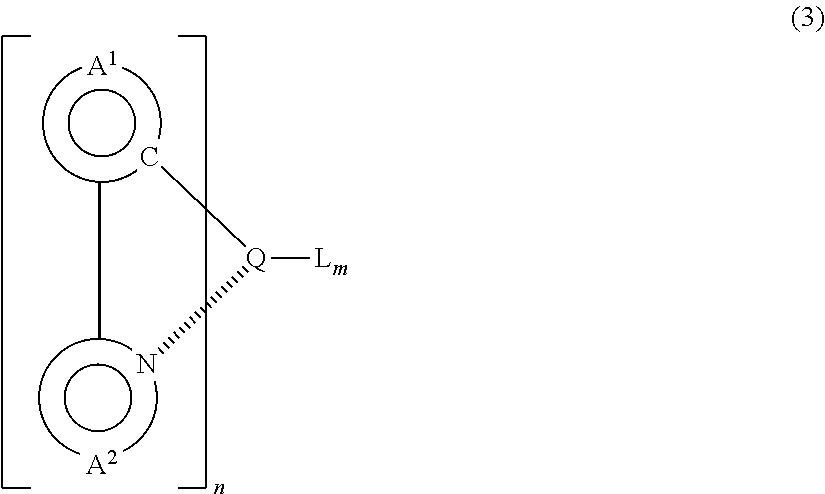Organic electroluminescent device
a technology of electroluminescent devices and organic materials, which is applied in the direction of thermoelectric devices, transportation and packaging, and other domestic objects, can solve the problems of deterioration, conventional electron injection constructions have problems, and the property of life or efficiency is degraded, and achieves the effect of great light emission efficiency
- Summary
- Abstract
- Description
- Claims
- Application Information
AI Technical Summary
Benefits of technology
Problems solved by technology
Method used
Image
Examples
example 1
[0132]A glass substrate (manufactured by GEOMATEC Company) of 25 mm×75 mm×1.1 mm thickness having an ITO transparent electrode was cleaned by application of ultrasonic wave in isopropyl alcohol for 5 minutes and then by exposure to ozone generated by ultraviolet light for 30 minutes. The glass substrate having the transparent electrode which had been cleaned was adhered to a substrate holder of a vacuum vapor deposition apparatus. On the surface of the cleaned substrate at the side having the transparent electrode, a film of copper phthalocyanine (referred to as a film of CuPc, hereinafter) having a thickness of 10 nm was formed in a manner such that the formed film covered the transparent electrode. The formed film of CuPc worked as the hole injecting layer. On the formed film of CuPc, a film of 1,1′-bis[4-N,N-di(p-tolyl)aminophenyl]cyclohexane shown below (referred to as a film of TPAC, hereinafter) having a thickness of 30 nm was formed. The formed film of TPAC worked as the hole...
example 2
[0141]An organic EL device was prepared in a similar manner as Example 1 except that PB 115 with electron transporting capability below was employed in place of the compound PB 102 as the host material in the light emitting layer.
[0142]The host materials in the light emitting layer, their ionization potential, their energy gap (singlet energy) and their triplet energy, the phosphorescent light emitting materials in the light emitting layer (metallic complex) and their triplet energy, the electron transporting materials in the electron injecting layer, their energy gap and their triplet energy and materials of the hole transport layer are shown in Table 1.
[0143]When a direct current voltage of 6.5 V was applied to the organic EL device prepared above, bluish green light was emitted with a luminance of 102 cd / m2 and a current efficiency of 14.8 cd / A. The results are shown in Table 1,
example 3
[0144]An organic EL device was prepared in a similar manner as Example 1 except that the foregoing BAlq was employed in place of Alq and Alq:Li forming the electron injecting layer, and that Li was added at 20 nm in the cathode side of BAlq. In this case, the light emitting layer directly adheres with the electron injecting layer, and the cathode adheres with BAlq layer.
[0145]The host materials in the light emitting layer, their ionization potential, their energy gap (singlet energy) and their triplet energy, the phosphorescent light emitting materials in the light emitting layer (metallic complex) and their triplet energy, the electron transporting materials in the electron injecting layer, their energy gap and their triplet energy and materials of the hole transport layer are shown in Table 1. When a direct current voltage of 7.8 V was applied to the organic EL device prepared above, bluish green light was emitted with a luminance of 93 cd / m2 and a current efficiency of 12.3 cd / A....
PUM
| Property | Measurement | Unit |
|---|---|---|
| ionization potential | aaaaa | aaaaa |
| electron mobility | aaaaa | aaaaa |
| triplet energy | aaaaa | aaaaa |
Abstract
Description
Claims
Application Information
 Login to View More
Login to View More - R&D
- Intellectual Property
- Life Sciences
- Materials
- Tech Scout
- Unparalleled Data Quality
- Higher Quality Content
- 60% Fewer Hallucinations
Browse by: Latest US Patents, China's latest patents, Technical Efficacy Thesaurus, Application Domain, Technology Topic, Popular Technical Reports.
© 2025 PatSnap. All rights reserved.Legal|Privacy policy|Modern Slavery Act Transparency Statement|Sitemap|About US| Contact US: help@patsnap.com



